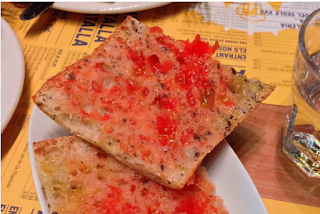by Maria José
Catalan pa amb tomàquet (bread with tomatoes). Image by Jo Cooke / Lonely Planet
Catalonia’s culinary heritage comes from Greek and Roman traditions. These two cultures are at the origin of the three key ingredient in the Mediterranean diet: olive oil, wheat and wine.
But Catalan cusine also owes to the Moors , who introduced new farming methods, as well as new products, such as rice, sugar and aubergines.
The evolution of Catalan cuisine was also marked by the discovery of America and the introduction of such products like the tomato, which has been used in almost every dish ever since. Above all, tomatoes are the key ingredient in “sofregit”, a sauce containing a mixture of peppers, garlic, onions and tomatoes slowly simmered over a low flame, and which forms the basis of countless Catalan dishes. Catalan cuisine has constantly absorbed influences that have helped to shape the country’s rich and diverse culinary traditions, in the region's culinary culture: sea and mountain;
The four culinary seasons
Autumn : Several mushroom types.
Winter : “Calçotada” (calçots are long, sweet onions that are grilled over red-hot embers);” xatonades” (xató is the traditional local salad, made from escarole, tuna and cod salad), rice dishes and casseroles, with white botifarra sausage and omelettes; as well as countless cod dishes.
Summer : llonganissa dry-cured sausage, seafood platters (mariscada) at one of Catalonia’s fishing ports.
Tapas:
An original way of dining out, serve aperitifs and “vermouth”, an aromatic wine before lunch.
Catalan pa amb tomàquet (bread with tomatoes).:is the most simple dish it serves with ham , dried pork sausage or cheese..
The Catalan version of the pizza is the coca:
There are many variations, both savoury and sweet. The savoury option can come with tomato, onion, pepper and sometimes sardines. The sweet version, generally almond-based.
Traditional desserts:
Crema Catalana, “ mel i mató” honey and fresh cream cheese, and “músic” – dried fruits and nuts served with a glass of sweet muscatel wine.
To know more bout it:


No hay comentarios:
Publicar un comentario